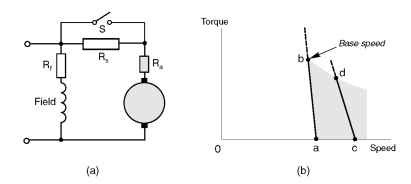Explain briefly about stunt motors. Compared to stunt and series which is a better motor. Do not provide any links
Dear Student,
SHUNT MOTOR
A basic shunt-connected motor has its armature and field in parallel across a single d.c. supply, as shown in Figure 3.12(a). Normally, the voltage will be constant and at the rated value for the motor, in which case the steady-state torque/speed curve will be similar to that of a separately excited motor at rated field flux, i.e. the speed will drop slightly with load, as shown by the line ab in Figure 3.12(b). Over the normal operating region the torque-speed characteristic is similar to that of the induction motor (see topic 6), so shunt motors are suited to the same duties, i.e. what are usually referred to as ‘constant speed’ applications.
Except for small motors (say less than about 1 kW), it will be necessary to provide an external ‘starting resistance’ (Rs in Figure 3.12) in series with the armature, to limit the heavy current which would low if

Figure 3.12 Shunt-connected d.c. motor and steady-state torque-speed curve
the motor was simply switched directly onto the supply. This starting resistance is progressively reduced as the motor picks up speed, the current falling as the back e.m.f. rises from its initial value of zero. In a manual starter the resistance is controlled by the operator, while in an automatic starter the motor armature voltage or current are sensed and the resistance is shorted out in predetermined stages.
We should ask what happens if the supply voltage varies for any reason, and as usual the easiest thing to look at is the case where the motor is running light, in which case the back e.m.f. will almost equal the supply voltage. If we reduce the supply voltage, intuition might lead us to anticipate a fall in speed, but in fact two contrary effects occur which leave the speed almost unchanged.
If the voltage is halved, for example, both the field current and the armature voltage will be halved, and if the magnetic circuit is not saturated the flux will also halve. The new steady value of back e.m.f. will have to be halfits original value, but since we now have only halfas much flux, the speed will be the same. The maximum output power will of course be reduced, since at full load (i.e. full current) the power available is proportional to the armature voltage. Of course if the magnetic circuit is saturated, a modest reduction in applied voltage may cause very little drop in flux, in which case the speed will fall in proportion to the drop in voltage. We can see from this discussion why, broadly speaking, the shunt motor is not suitable for operation below base speed.
Some measure of speed control is possible by weakening the field (by means of the resistance (Rf ) in series with the field winding), and this allows the speed to be raised above base value, but only at the expense of torque. A typical torque-speed characteristic in the field-weakening region is shown by the line cd in Figure 3.12(b).
Reverse rotation is achieved by reversing the connections to either the ield or the armature. The field is usually preferred since the current rating of the switch or contactor will be lower than for the armature
COMPARISON BETWEEN SHUNT MOTOR AND SERIES MOTOR

- shunt field are parallel and hence have low current. Therefore it have more number of turns and core gets saturated due to which flux will be constant.
- Series motor have series winding and thus a high armature current is same as field current.Due to which
- resistance of field winding is low.Core flux is linear.

- shunt field are parallel and hence have low current. Therefore it have more number of turns and core gets saturated due to which flux will be constant.
- Series motor have series winding and thus a high armature current is same as field current.Due to which resistance of field winding is low.Core flux is linear.

